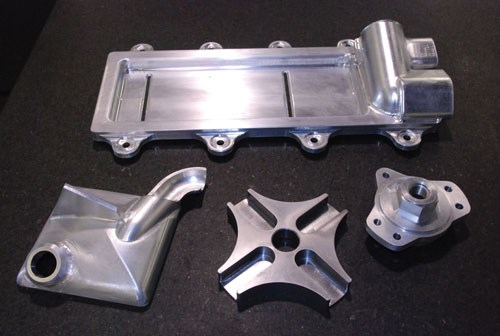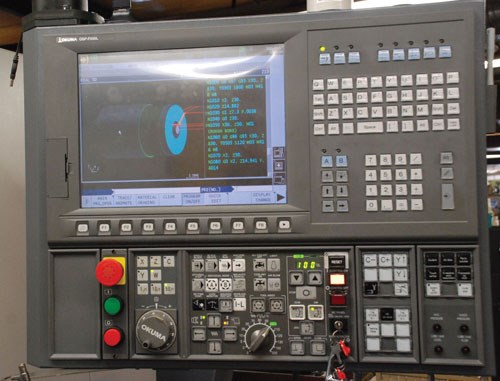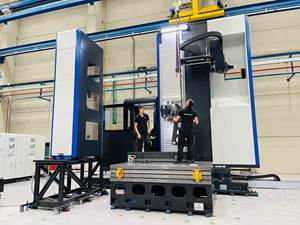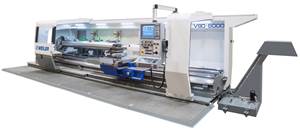Lathe with Multitasking Capability Helps Shop Stay Competitive
Purchasing a multitasking turning center has helped Mercer Machine Tool accept a wider range of jobs to ensure the future of its business.
Maintaining a competitive business in an industry that is fighting to keep jobs from being outsourced and still recovering from the recent recession is no easy task, but Mercer Machine Company sticks to a simple plan: Cast a wide net. While shops that focused on a handful of uncomplicated, high-volume jobs that easily could be sent abroad closed down, Mercer invested in advanced technology to win work its competitors wouldn’t attempt. By using a CNC turn-mill from Okuma (Charlotte, North Carolina), the shop was able to improve quality while reducing operator involvement.
Wayne Mercer founded Mercer Machine Company in 1954 in his basement with only a single lathe. Today, Brian and Tracy Robinson, who bought the business in 2008 from Tracy’s parents, run the company. Now, the 14,400 square-foot facility in Indianapolis, Indiana, staffs 16 full-time employees and runs 22 hours a day. Operations include production sawing, turning and milling as well as some EDM work on common materials ranging from carbon steels and aluminum to more exotic materials like Hasteloy, titanium, Inconel, Waspoloy, and more. The company serves the automotive, racing, agriculture and defense industries, and it is taking a hard look at aerospace and medical industry applications as well.
“We’ve always been a very lean operation, and we’ve never put all our eggs in one basket,” says Brian Robinson, vice president of Mercer. The company has always had a highly diversified customer base, and it only selects requests for quotes (RFQs) that require multiple secondary operations, he says.
This turned out to be a wise decision with the outsourcing trend that took off in the 1980s and 1990s. Mr. Robinson says that as a businessman, he can understand the perception that the overall cost of manufacturing is cheaper overseas. However, he says, companies tend to ignore the other costs associated with offshoring because they are busy chasing cheap labor. That mindset, along with the recent recession, caused a severe upheaval and many casualties in the precision-parts-making business. Mercer credits its new Okuma LB3000 EX-MY CNC turn-mill for keeping the company from becoming another causality.
No stranger to Okuma CNC machine tools, Mercer purchased its first Okuma lathe in 1976, and has since added to the lineup. Mercer’s most recent purchase is built on a high-quality box slant bed and its thermal design achieves machining dimensional change that is within 5 microns of the turned diameter. Further, the LB3000 EX-MY offers a maximum machining diameter and length of 16.14 inches and 19.69 inches, respectively. The machine’s ball-screw-driven tailstock, along with X- and Z-axis rapid traverse rates of 984 and 1,181 ipm, respectively, increase accuracy and flexibility. In addition, the machine can be equipped with a subspindle (W), a Y axis, two bed sizes (500 and 1,000 mm), two spindle sizes, and milling capability to in-crease the lathe’s ability to fit a wide array of applications and needs. “It’s amazing what you can do with the new machine,” Mr. Robinson says. “Suddenly you’re doing things that no one tells you that you can do. If you can imagine the shape and geometry of a complex part, you can program and produce the part in a single setup.”
A major benefit of the lathe is that it decreases operator involvement. A bar feeder and parts catcher keep the new Okuma running until it is out of stock. “It runs without operator intervention and keeps my quality and throughput consistently high,” Mr. Robinson says. “Without operator involvement, I don’t have operator-induced variances. I can run simple parts and very complex parts. The lathe is just tremendous at repeatedly holding tolerances and surface finishes.”
For example, a simple part made at Mercer includes a pin for electrical transformers that requires drilling a cross hole through the diameter, chamfering both sides and parting off. The lathe reduced cycle time from nearly 3 minutes to 67 seconds by eliminating three distinct setups in which operators moved the part, Mercer says. It also reduced potential quality variations from pin to pin. Now, the part is done in a single setup.
Mercer is also able to use the turn-mill for more complex applications. For instance, in 3.5 minutes, the company is able to take a 3-inch-long piece of barstock, bore the jaws out, rough turn the part, finish turn the part, thread a 3/4-inch-10 thread on the end, and mill and drill three holes in the flange face in a single setup. This ability has greatly reduced the cycle time, workholding fixtures and operator involvement that were necessary before, when a variety of machines and multiple setups were used to make the aerospace part, Mr. Robinson says.
Keeping an eye on its customers, competitors and technological developments is part of the long-term business strategy that has helped Mercer stay competitive. “We’ve always known there would be some very hard times, and we intentionally tucked money away for just those times,” Mr. Robinson says. “We invest regularly to stay ahead of the competition, enabling us to do what others cannot.”
Related Content
How to Start a Swiss Machining Department From Scratch
When Shamrock Precision needed to cut production time of its bread-and-butter parts in half, it turned to a new type of machine tool and a new CAM system. Here’s how the company succeeded, despite the newness of it all.
Read MoreControlling Extreme Cutting Conditions in Large-Part Machining
Newly patented technologies for controlling chatter and vibration during milling, turning and boring operations promise to drastically reduce production time and increase machining performance.
Read MoreModern Bar Feeds Bring New Life to Automatic Swiss Lathes
Cam-actuated Swiss lathes are still the fastest way to process many parts. By adding modern bar feeders, this shop has dramatically improved their utilization with the ability to work unattended, even in a lights-out environment.
Read MoreWeiler to Debut New Automation Features For Its Lathes
Weiler’s V 110 four-way precision lathe introduces features new to the U.S.
Read MoreRead Next
3 Mistakes That Cause CNC Programs to Fail
Despite enhancements to manufacturing technology, there are still issues today that can cause programs to fail. These failures can cause lost time, scrapped parts, damaged machines and even injured operators.
Read MoreThe Cut Scene: The Finer Details of Large-Format Machining
Small details and features can have an outsized impact on large parts, such as Barbco’s collapsible utility drill head.
Read More














.png;maxWidth=300;quality=90)

.png;maxWidth=300;quality=90)











